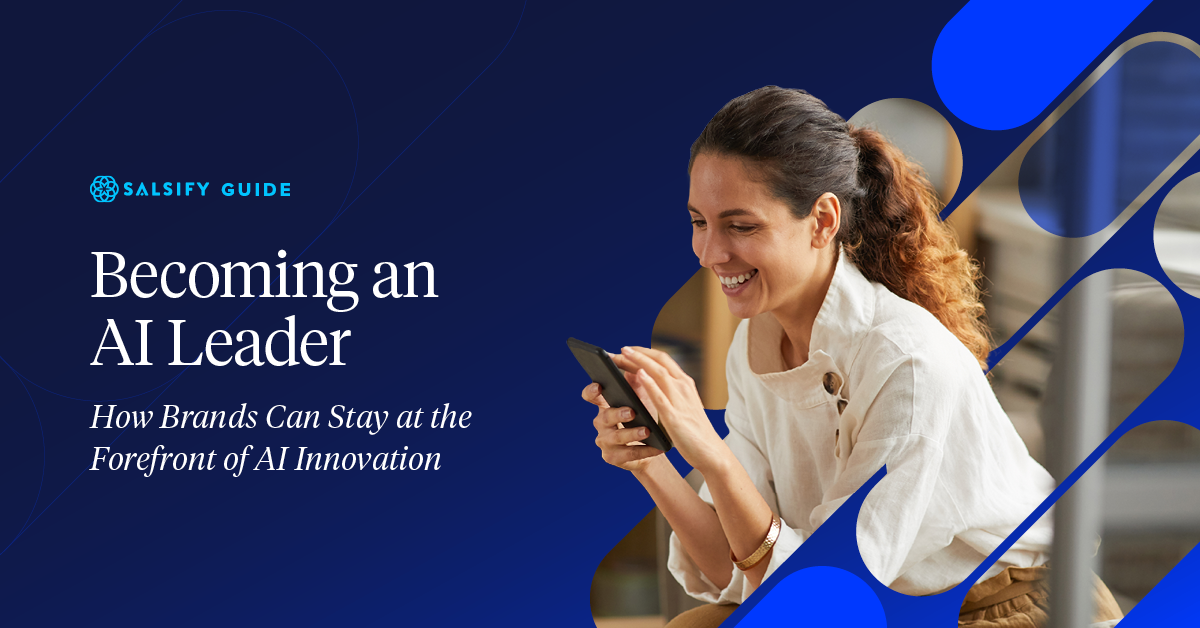AI in Ecommerce: Why Your Brand.com Site Should Be Your AI Training Center
Written By: Lizzie Davey
Every time a shopper searches for a product, clicks a recommendation, or chats with a virtual assistant, there’s a good chance artificial intelligence (AI) is working behind the scenes. It’s learning everything it knows from you, especially from your brand.com site.
As large language models (LLMs) and generative AI (GenAI) tools become more deeply embedded in how consumers discover, research, and buy products, your brand website is doing double duty.
As well as being a polished storefront designed to convert human visitors, it’s also a strategic data source feeding the AI systems that power everything from search results to shopping assistants to personalized product detail pages (PDPs).
That shift has huge implications for ecommerce and digital shelf teams because the content on your brand site (like product specs, reviews, how-to guides, images, and FAQs) now shapes how AI represents your brand across the entire digital shelf.
To lead in an AI-driven future, you must stop thinking of your website as a static destination and start treating it like a dynamic training ground.
The better your site content, the better equipped AI is to understand and promote your products in a way that drives real results.
Foundation Models Learn From You — Whether You Realize It or Not
When people think about AI in ecommerce, they often imagine something futuristic. But the real magic happens during training. That’s where foundation models learn how to talk, answer questions, and recommend products. And they learn it from one main source: your content.
These foundation models comb through massive amounts of publicly available data to understand the world. And if you’re a brand with a solid online presence, you’re already part of their curriculum, whether you’ve volunteered for the job or not.
One increasingly popular method for this training is retrieval-augmented generation (RAG). In simple terms, this means that instead of relying purely on pre-trained knowledge, AI models can “reach out” to trusted sources in real-time to validate or enrich their answers.
Your brand.com website isn’t just influencing your customers anymore; it’s also influencing the answers AI gives your customers.
As a result, digital shelf teams are in a powerful position. Yes, you’re publishing content for shoppers, but you’re also shaping how AI understands your brand, products, and value proposition.
If your site has accurate, structured, and up-to-date product content, AI is more likely to surface your brand in recommendations, search results, and conversations. But if your content is incomplete or inconsistent, that confusion gets baked into the AI’s outputs.
The Brand Site’s New Dual Purpose: Serving Humans and Machines
Your brand.com website has always been where shoppers go to learn about your products, compare options, and (hopefully) hit that “buy” button.
But now it’s for machines too.
Generative AI tools and LLMs are acting as “copilots” for the shopping experience. They answer customer questions, surface product recommendations, and even write PDP content. But they can only be as good as the data they’ve been trained on.
This shift demands a new way of thinking about optimization. In the past, you might have focused on traditional search engine optimization (SEO) to make sure your pages ranked well in Google.
Now, brands are looking beyond search engines to optimize for AI engines:
- Generative engine optimization (GEO): Making sure generative tools like ChatGPT surface your brand in user prompts.
- Agent engine optimization (AEO): Making sure AI-powered assistants like Siri, Alexa, or Google Assistant can reference your products accurately.
- Large language model optimization (LLMO): Structuring and improving the content LLMs are trained on so they can better retrieve, generate, and contextualize product information.
Why Every Product Experience Matters More Than Ever
We’ve all bounced from a product page that had blurry images, vague descriptions, or conflicting specs. But what used to be a frustrating human experience is now an issue with much wider impact because AI is watching and learning.
Today, every product experience matters, not just for the shopper, but for the AI systems learning how to talk about your brand.
The better your content, the better AI will get at accurately surfacing your products in search, helping shoppers find what they need, and improving recommendations.
This is especially important on your brand site, which acts as a clean, authoritative source for your entire digital presence. If your product title says one thing, your description says another, and your review content introduces a third variation, AI won’t know what’s true. And if it’s unsure, it might not recommend your product at all.
To build strong AI-powered experiences, brands need:
- Structured content with clean specs, consistent formatting,and schema markup.
- Validated content that’s fact-checked, reviewed, and aligned across teams.
- Up-to-date content with no lingering seasonal offers from last year.
- When your product data checks all those boxes, you’re giving your shoppers a better experience and training AI to be a more accurate, effective advocate for your brand.
The Role of PXM in Preparing for an AI-First World
Winning brands aren't just adopting AI — they're selecting PXM platforms that integrate AI throughout the product content ecosystem. A comprehensive PXM solution provides the governance and structured workflows needed to make AI-powered content scale safely and effectively.
With a PXM platform that offers AI tools and solutions, brands can:
- Build scalable, repeatable processes;
- Collaborate more effectively across teams;
- Reduce manual efforts;
- Build content-rich experiences;
- and so much more.
The brands partnering with forward-thinking PXM providers will shape how AI evolves in commerce. If you haven't selected a PXM platform with robust AI capabilities and an innovation roadmap, now is the time to start.
How To Make Your Brand.com Website AI-Ready
You don’t have to reinvent the wheel to make your brand.com website AI-ready. Instead, you simply need to tighten up the content and systems you already have so it’s geared towards humans and AI.
Here’s a checklist to get you moving in the right direction.
Audit Your Current Product Content for Completeness and Accuracy
Outdated specs, missing images, or vague descriptions frustrate customers and confuse AI. Start with a content health check to spot gaps.
Collaborate With Marketing and Legal Teams To Standardize Tone and Claims
AI is great at pattern-matching, but it can’t read between the lines. You’re far more likely to stay consistent if you align on voice, phrasing, and approved messaging.
Make Sure You Use Structured Data Markup
Structured data helps search engines and LLMs interpret your content correctly, whether that’s product dimensions, availability, or reviews.
Set Up Pipelines Between Your Pxm and Your Brand.com CMS
Build automated connections so updates in your PXM flow directly to your website. This means your training data is always fresh and accurate.
Monitor AI-Powered Channels To See How Your Brand Is Represented
Curious what ChatGPT says about your bestselling product? Ask it. Check tools like Perplexity or even Google’s AI Overviews to see how your brand shows up. If the answer isn’t great, that’s your cue to optimize what you're feeding AI.
Future-Proofing for AI in Ecommerce Starts With Your Foundation
Your brand site has always been important. But in the age of AI, it’s become something even more powerful: a strategic training center for the future of ecommerce.
As large language models and generative tools continue to shape how consumers discover and shop for products, your website will serve as a key source of truth, not just for customers, but for the AI tools advising them.
Now is the time for ecommerce leaders and digital shelf teams to step up. The brands that win in the AI-driven future won’t be the ones with the flashiest tech. They’ll be the ones with the clearest content, the cleanest data, and the smartest systems.
Audit your site, align your team, and make your brand the one AI recommends first. AI is already learning from your content; the question is whether you’re teaching it the right things.

Becoming a Leader in AI for Ecommerce
Want the full picture of how AI is transforming ecommerce? Download our guide to explore practical strategies, expert insights, and real-world examples that will help your brand stay ahead of the curve.
DOWNLOAD GUIDEWritten by: Lizzie Davey
Lizzie Davey (she/her) is a freelance writer and content strategist for ecommerce software brands. Over the past 10 years, she's worked with top industry brands to bring their vision to life and build optimized and engaging content calendars.
Related Posts
Navigating Digital Minimalism During the Rise of AI
Your Conversational AI Assistant: Why Ecommerce Chatbots Aren’t Just for Shoppers
Where Agentic Commerce Fits in the New Era of Shopping
Subscribe to the Below the Fold Newsletter
Standing out on the digital shelf starts with access to the latest industry content. Subscribe to Below the Fold, our monthly content newsletter, and join other commerce leaders.

.svg)